The Managed Meadow
The work on the Managed Meadow began in 2018 with the help of many volunteers and community partners. What started as an empty stormwater ditch has become a haven for pollinators and wildlife, critical to maintaining our local environment and offering a botanical departure from the industrial setting surrounding the meadow.
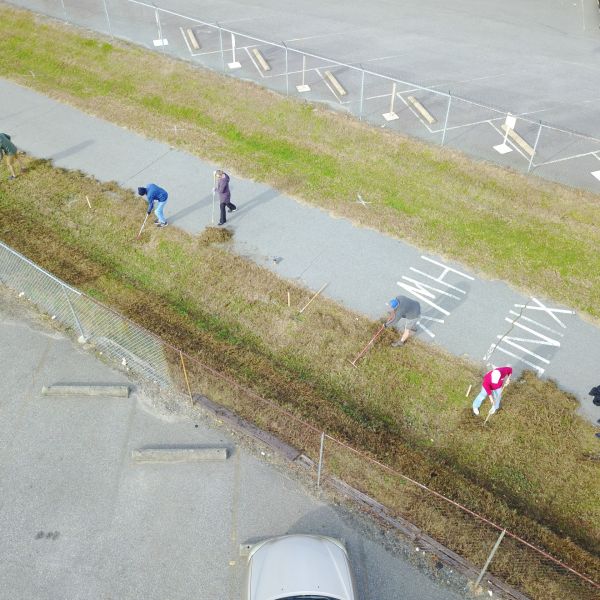
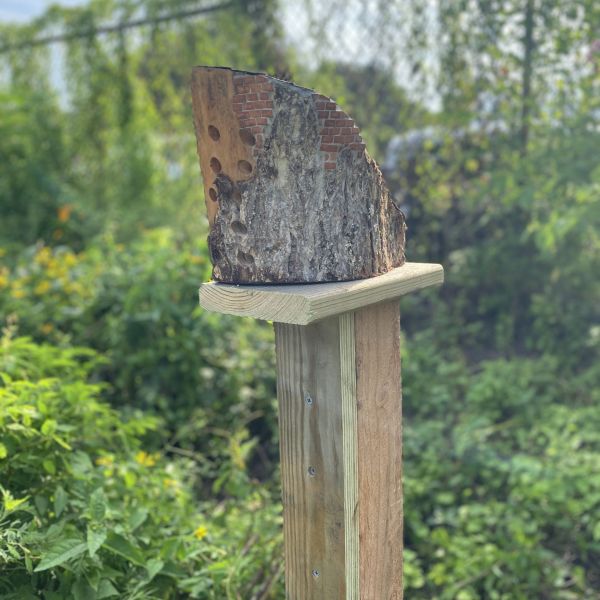
The Elizabeth River Trail Foundation is committed to the beautification and preservation of the green spaces the trail traverses. The Managed Meadow represents one of the largest projects along the trail for that purpose.
The Managed Meadow is broken into three sections. Section one is located behind Benchtop Brewery and features a bee hotel donated to the trail by local artist Heather Beardsley.
Did you know bees travel up to 5 miles per day? The Meadow is both a home and the grocery store for local pollinaotrs. Areas like this are vital to urban environments where pollinators must search far and wide for resources. Plants like Bee Balm and Lanceleaf Coreopsis are important food sources. Milkweed is a host plant for Monarch Butterflys. Even the more tree like Partridge Pea is an important host plant for Sleepy Orange, Little Yellows, and Ceraunus Blues Butterflys.
Sections two and three of the Managed Meadow, moving south from West Olney Road, are particularly vibrant. Loaded with Curly Dock, Golden Rod, and Trumpet Honeysuckle, these sections boast plenty of color in spring, summer, and fall. Trumpet Honey Suckles, growing on the fence line, are very attractive to hummingbirds, many of which are migrating through our region in late spring and early summer. The dense foliage from the Trumpet Honey Suckle and the surrounding plants is home to many birds who feed off the seeds and insects that call the Managed Meadow home.
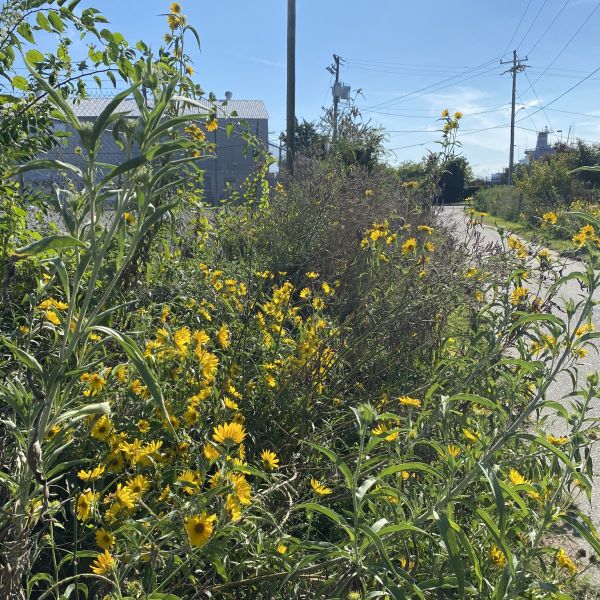
Lambert’s Creek Wetlands
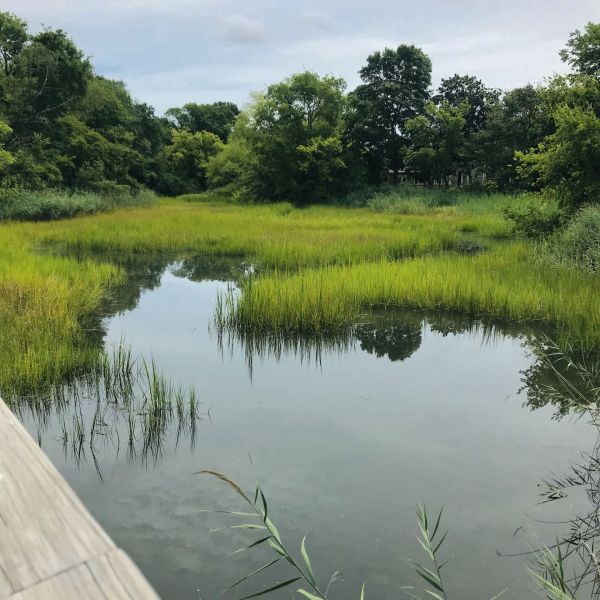
Traveling from Jeff Robertson Park to the Chelsea Business District along the ERT, you’ll come to a beautiful wooden bridge spanning Lambert’s Creek, a tidal wetland habitat.
What are wetlands?
Located where land meets water, wetlands—which include marshes, swamps, and bogs—are low-lying areas covered by water some or all of the time. The Chesapeake Bay watershed includes 1.5 million acres of wetlands.
Why are Wetlands Important?
Wetlands, often undervalued by humans, are among the most productive, diverse, and important ecosystems in the watershed. They improve water quality, reduce storm damage and flooding, control erosion, provide vital wildlife habitat, and help fight climate change. Wetlands provide some of the most productive habitat for widely diverse wildlife. Their rich vegetation provides food, shelter, spawning, and nursery areas for fish and shellfish; wintering grounds for migrating waterfowl; and shelter and food for amphibians, reptiles, mammals, and birds.
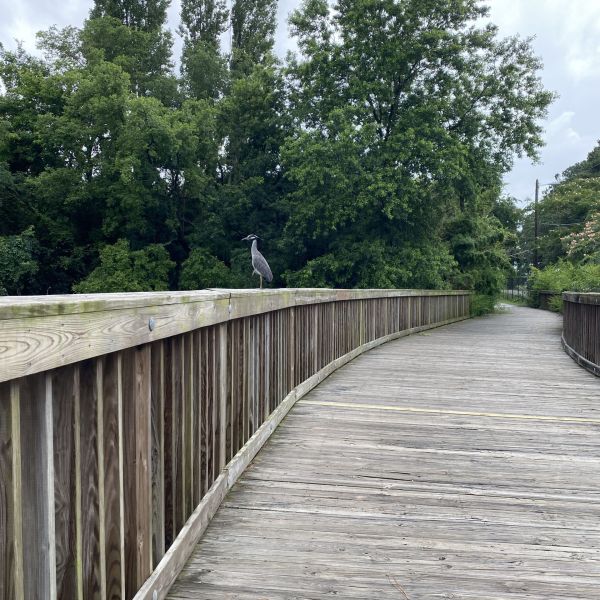
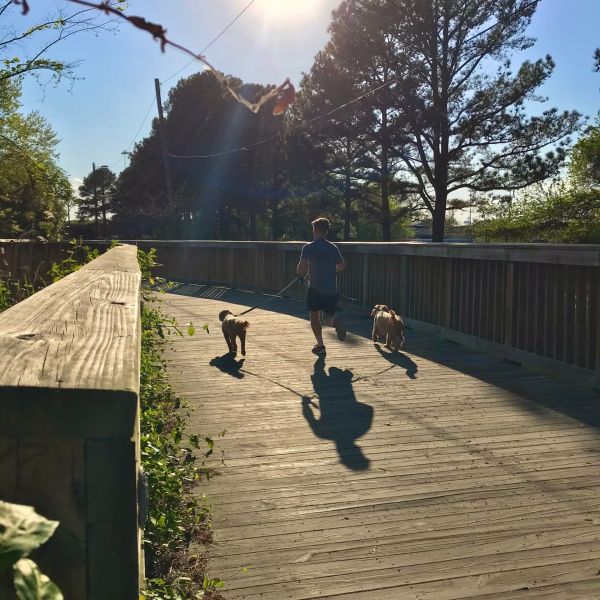
What Are the Threats to Wetlands?
Unfortunately, the Chesapeake’s wetlands are threatened by development, rollbacks of federal regulations, invasive species, and the effects of climate change, including sea level rise, flooding, drought, increased heat, and more frequent and severe storms.
Invasive, non-native plants and animals threaten native wetland species by crowding them out, establishing themselves more quickly, or otherwise disrupting natives’ ability to thrive. Plants like purple loosestrife, Japanese stiltgrass, and especially phragmites have overrun Chesapeake wetlands, crowding out other native species and eliminating food supplies and habitat for native wildlife.
Enhancing and Protecting Green Spaces
Environmental projects of varying types, purposes, and sizes, can be found along the ERT. Starting at the northern end of the trail, there are two restored wetland areas, at Larchmont Library and Myrtle Park.
Did you Know?
Wetlands can store 50 times more carbon than rainforests, helping keep this climate-change-related gas out of the atmosphere. They trap high-carbon detritus, such as leaves, animal waste, and other debris, below the water’s surface. Wetlands’ flooding and erosion control functions can also help reduce the impacts of climate change.
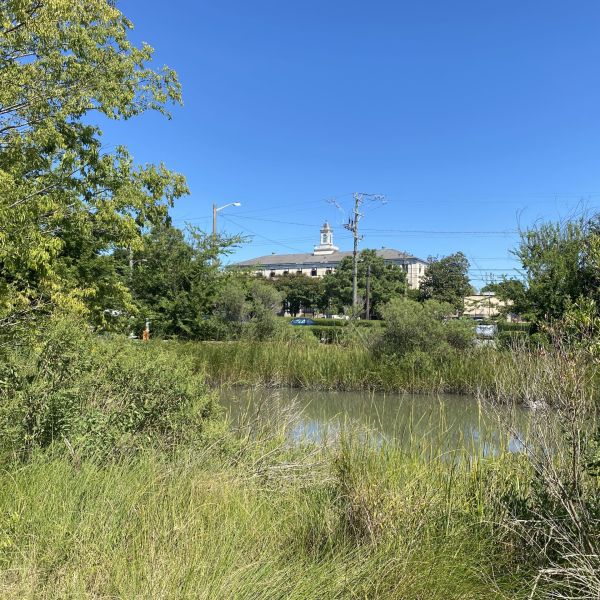
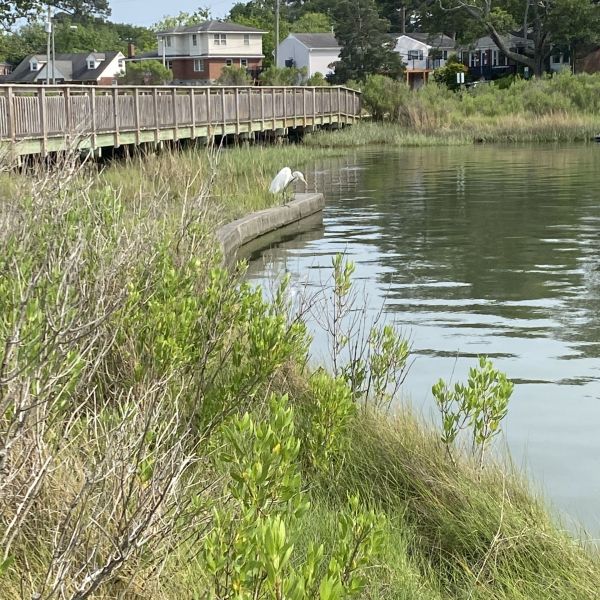
Wetlands also help with erosion control. The wide variety of plants, bushes, and trees that grow in wetlands bind the soil, preventing extensive erosion and controlling sediment. In addition, the shoots of wetlands vegetation slow down the flow of water, allowing fine sediment particles to settle, building soil elevation over time.
Moving south, past Old Dominion University, you’ll find the Lambert’s Point Micro Garden. This open green space received new trees in April of 2024 thanks to the support of Alpha Kappa Alpha Sorority and the City of Norfolk’s Department of Urban Forestry as a part of Celebrate Trails Day.
Trees are an important part of creating a welcoming trail and enhancing our local environment. The City of Norfolk Green Infrastructure Plan includes the goal of planting 5,000 trees each year to help restore Norfolk’s tree canopy. The ERT is one of many organizations supporting that effort.
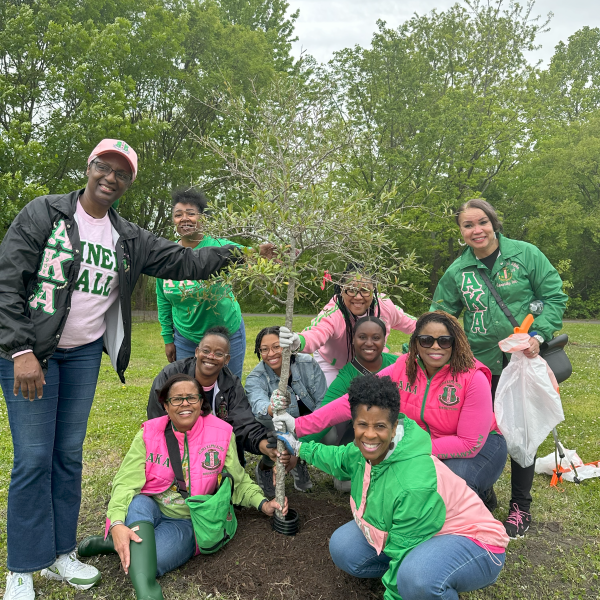
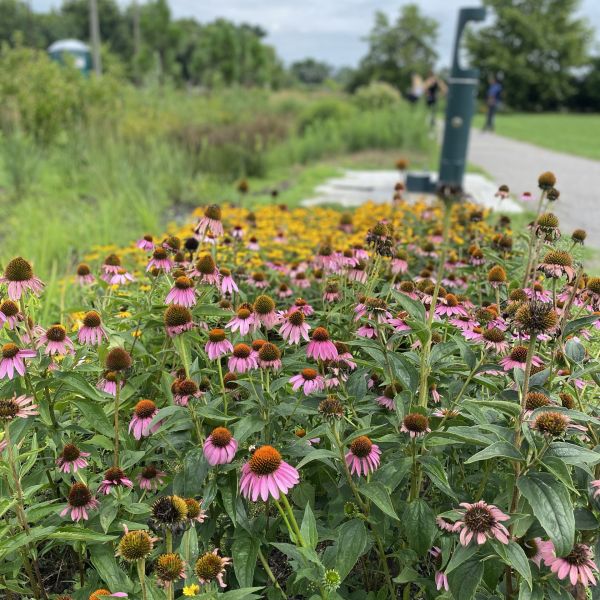
In Jeff Robertson Park you will find the Olmsted Garden, installed in 2022 by the Garden Club of Norfolk. The first-ever ERT hydration station received support from the Garden Club to include a hose connection to ensure the plants could be watered. The garden is a habitat, greenway, and stormwater management system. This space used to hold nothing but sand, dirt, and water. Now, it is home to a variety of plants placed strategically to create an eco garden that helps retain and filter stormwater.
After passing through the Managed Meadow and over the Midtown Tunnel, trail users are greeted with a breathtaking view of the Elizabeth River. Here you will also find the Double Turbo Charged ERT Fitness Course! If you aren’t looking to workout, this is a great spot to take a break. In 2021 the ERT and community partners planted trees, including several Longleaf Pines.
Native to the southeast, Longleaf Pines are an important habitat to many animals and birds. Over-harvesting for ships and pine tar nearly caused the end of these trees in our region. Trees are technically a renewable resource, however many species like the Longleaf Pine take decades to grow to maturity, when their benefits to an ecosystem are profound. The ERT Foundation is proud to be able to help bring these trees back to our community.

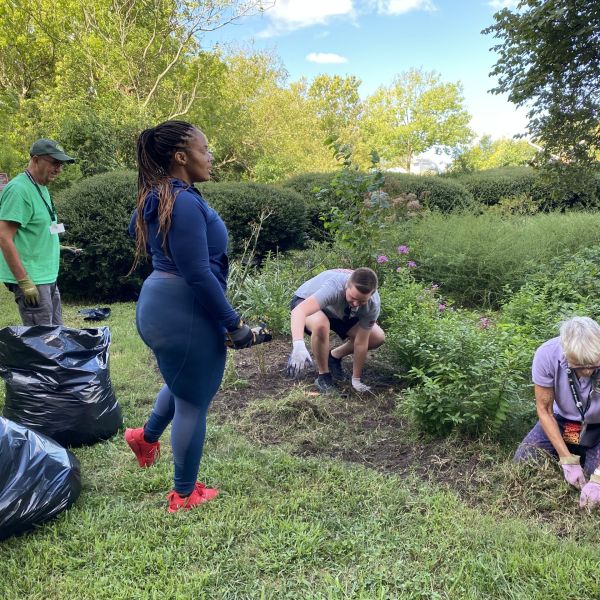
Just past the Fitness Course by the ERT kayak launch is the Monarch Waystation. Created as an Eagle Scout Project in 2022, the Monarch Waystation continues to thrive thanks to the continued support of the Eagle Scout, volunteers, and Norfolk Master Gardeners. Along with the Milkweed, the Monarch Butterfly host plant, there are plenty of other native species to attract pollinators of all kinds including the aptly named Beauty Berry which produces a bright purple berry in the fall!
The ERT Donor Sculpture was erected in 2021 as part of the Capital Campaign that helped launch the trail we know and love today. Since then, many hands have helped maintain the garden bed surrounding the sculpture, which can be found just outside of The Pagoda and Oriental Garden and mimics sails, paying tribute to our working waterfront.
In the spring of 2024, Norfolk Botanical Garden donated nearly 200 native plants to the Donor Sculpture bed. This addition brings more color to the space, helps crowd out the aggressive Bermuda grass, and creates yet another space for pollinators and birds. The site continues to be maintained with the help of the ERT Green Team and Norfolk Master Gardeners.
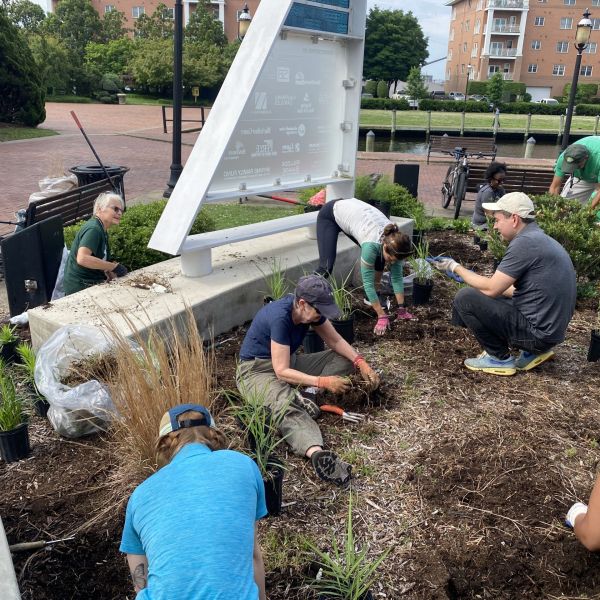
More Information is coming soon!
We are continuing to update this page with more information on the beautiful green spaces you can enjoy along the ERT!

